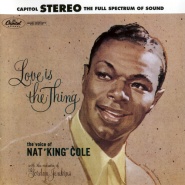A Pile o' Cole's Nat King Cole Website
Site Menu
Love is the Thing
Recorded 12/19/56 & 12/28/56
Nat Cole - Vocals
Gordon Jenkins - Arranger
Lee Gillette - Producer
John Kraus - Engineer
Rex Uptegraft - 2nd Engineer
Capitol W-824 - mono LP (1957)
Capitol EAP-824 - mono EP set (1957)
Capitol ZW-824 - stereo open reel tape (1957)
Capitol SW-824 - stereo LP (1959)
- When I Fall in Love
- Stardust
- Stay as Sweet as You Are
- Where Can I Go Without You?
- Maybe It's Because I Love You Too Much
- Love Letters
- Ain't Misbehaving
- I Thought About Marie
- At Last
- It's All in the Game
- When Sunny Gets Blue
- Love is the Thing
"In case any had doubted, Nat King Cole the vocalist proved his vocal arts had reached the pinnacle of the craft in this massively popular, lushly orchestrated set of ballads."
The title says it. In case any had doubted, Nat King Cole the vocalist of popular song proved his vocal arts had reached the pinnacle of the craft in this massively popular, lushly orchestrated set of ballads. Gordon Jenkins scored his trademark soaring strings for a dramatic and atmospheric orchestration to underscore and envelop, not merely accompany, the exquisite vocals of Nat.
There's no brass section and no choir, only strings. This frees Gordon Jenkins to do some of his best work, distilling his style to its essence as the songs and Nat's vocals distill the subject of love to a romantic ideal. Here is love looked towards as an ideal and as something one is in; later, Nat and Gordon would be reunited to take this theme to the next stage with The Very Thought of You.
Despite how easily such work treads the line from romantic to schmaltz, Love is the Thing proves incredibly successful and consistent. For as richly romantic as the material and settings are, the sensibilities informing the performances, arrangements and production are of unerringly high quality with tasteful directness and restraint. After fifty years and numerous recordings by other artists, the performances here of Stardust and When I Fall in Love are still definitive. Those two tracks would have made the project worthwhile, but there are still more wonderful moments, including a particularly enchanting When Sunny Gets Blue and a surprise recasting of Fats Waller's normally quite upbeat Ain't Misbehavin' as a slow ballad.
It's All in the Game was a remake of a standard perhaps most popularized by Tommy Edwards, both before and again after Nat's recording. One example of Nat's way with a lyric and melody can be found in a lesser-known track, Maybe it's Because I Love You Too Much. In the lyric 'Maybe with a love so great / and a love so small' he phrases the first instance of the word love with an emphasis that intuitively would befit the word great, but melodically works on love; the actual effect brings the listener's musical emphasis to love and attention to expression drawn to the softer-spoken great, the listener intuitively carrying over his emphasis from the word love. And he goes right on to enlarge the word small, which again has a counter-intuitive effect to the listener. It all sounds quite instinctive to him, rather than calculated. Whichever it was, it is the work of a master.
The title song may be the weakest of the lot, but it perfectly sums up the album's theme. Or thing?
Further notes regarding the engineering:
Love it the Thing was the first Nat Cole project to be recorded in stereo and one of the earliest stereo recordings made by Capitol. Stereo recording was a largely dedicated operation at this time, with the mono recordings being engineered and supervised for general releases while the stereo recording was made for the recent niche hi-fi stereo tape market. Unfortunately the first two tracks (Maybe It's Because I Love You Too Much and Love Letters) were not recorded in stereo due to technical problems with the stereo equipment; they fixed the problem just in time to begin stereo recording with the third song (I Thought About Marie). Due to differing mic arrays and placements, instrumental balances vary between the stereo and mono recordings. A notable example are the cellos opening When I Fall in Love; they are clearly audible in the mono recording and all but inaudible in the stereo recording.
The original recording engineer was John Kraus with second engineer Rex Uptegraft. On 1/8/57 Rex Uptegraft assembled the mono master tape assembly and cut the approved lacquer reference; on 1/10/57, Hal Mulhonen and Frank Carter cut the production lacquer masters for the primary original release, mono LP Capitol W-824. A stereo mix was created and issued on 2-track open reel tape ZW-824 (the identity of the engineer is unknown at this time).
In 1959, after the introduction of the stereo LP, a new (and inferior) stereo mix was issued on stereo LP (and 4-track open reel tape). New stereo mixes of varied quality were created for most re-releases, with the perhaps the most widely available being the remix by Larry Walsh of Capitol Mastering for Capitol CD. The finest sound quality of both mono and stereo recordings to date may be found via the remixes (stereo) and mastering of Steve Hoffman and Kevin Gray for the Analogue Productions label.
